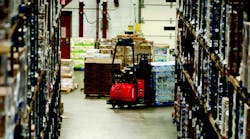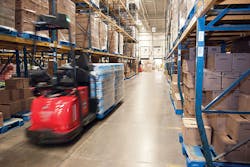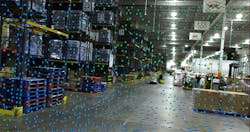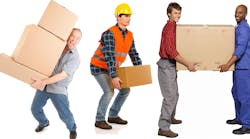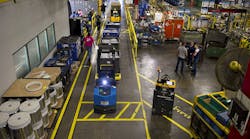Seeing is Believing: Putting Faith in Automated Vision Guided Vehicles
What do you get when you combine Seegrid's unparalleled automated guided vehicle solution with the efficiency of Raymond Corp's electric lift trucks?
To start with: flexibility. All the infrastructure you'll need is built onto the trucks; the Courier line also comes with a manual mode, so there's no material situation the Courier 3010 pallet truck and Courier 3020 tow tractor can't handle. They are essentially plug-and-play.
Jeff Christensen, Seegrid VP of products, describes the paring as "peanut butter and chocolate."
You'll be able to get a taste at ProMat 2017 at Raymond Booth #S3218, where both companies will be on hand to show off how Seegrid's automated vehicle solution and Raymond Corp's efficient lift truck design combined to offer an excellent segue into automated material handling.
Photo: Raymond Corp.
Here's what to know.
Like other Seegrid-based automated vision guided vehicles (VGVs), Raymond's automated lift trucks employ 360-degree stereoscopic Vision to guide the way, as opposed to magnetic tape or Lidar. A facility employing these VGVs can change portions of a route or the entire path on the fly because they see the way humans do—with depth perception. There's no need for wires, targets, or reflectors, so you essentially plug-in the route for whatever application is needed that shift.
"Stereo vision tech is best for infrastructure-free navigation," says Jeff Christensen, VP of products for Seegrid. "It's the most reliable, data rich option for interior spaces."
Of course he would say that, but the 600,000+ safely traveled miles these VGVs have accrued hauling cargo for Whirlpool, Volvo, BMW, and others seem to back that claim up. Seegrid vehicles have also consistently demonstrated ROI in less than a year.
And the center rider and tugger, both 24-V, are based off Raymond's successful 8000 series, with 8,000 and 10,000-lb. max capacities, respectively.
"From an entry level perspective, it's an excellent vehicle to get a site up to speed in the automated realm, says Chris Merta, product manager for Raymond Corp.
Along the complete spectrum from manual operation to full automation, Merta explains that a 3010 or 3020 Courier could be seen as a "semi-automatic" solution because of its dual mode capability, which seems to be a growing trend in the industry. Ideally, you would program and insert them into your process, and then they'll chug along day and night moving pallets and carts back and forth without human intervention.
And if there's an unexpected task, the Courier also acts as a manually operated forklift; just step on the machine and you can manually control the vehicle with the ergonomic steering wheel. There's no need for a remote control.
Photo: Raymond Corp.
For constantly changing floorplans, such as in the aerospace industry, Merta says the Courier lift trucks have served well in the short time they have been available. The 3020 tow tractor became widely available only last summer.
Any conversation concerning automated vehicles must start and end with safety.
Because of the vehicles' superior evidence grid technology, developed by Seegrid founder Hans Moravec, they can determine environmental changes in the routes, which is safer for the truck and anything in its path.
Photo: Seegrid
"Lidar units have a whole host of problems, especially in environments that change a lot," Christensen says. "They get lost when a box moves or a rack changes or some sort of operational change happens."
The Courier identifies obstructions from 16 to 18 feet away, and will slow down until the obstruction moves out of way, stopping when it doesn't. A safety curtain also envelopes the vehicle and will activate a full-stop if the plane is broken.
Merta says a recent pharmaceutical customer bought both the 3010 and 3020 models for its handling operations not only because of the flexibility or ROI, but because "they wanted to reduce pedestrian and forklift interface as much as possible."
The Industrial Truck Association estimates there are about 856,000 forklifts operating in the U.S., and considering OSHA says they are involved in about 100,000 accidents annually (85 fatal), that means 11% will be involved in an accident.
Merta says an aerospace manufacturer who recently bought several Courier tow tractors has already noticed a change in its plant operations in safety and overall efficiency.
With the automated tuggers on the job, the workers take greater care not to leave materials and tools in the automated route, which at this facility is marked with duct tape.
"One of the greatest things they've gained is how their 5S processes have dramatically improved," Merta says. "They have rewritten some of their production and workplace processes to accommodate the VGVs."
For larger operations, an automated Courier fleet can rely on both Seegrid's Supervisor platform and iWarehouse fleet management system, which keep track of the vehicles and gather and analyze performance data to help a plant manager optimize operations. In the event of an incident or disaster, the software can also order the lift trucks to stop in place or move out of the way of emergency vehicles.
Overall, the main mission of these lift trucks is to put every manufacturer and distribution center on the path to automation, because while manual operation can be convenient at times, automation can be a more efficient and economical option for many applications.










